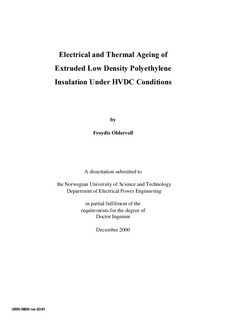| dc.contributor.author | Oldervoll, Frøydis | nb_NO |
| dc.date.accessioned | 2014-12-19T13:50:39Z | |
| dc.date.available | 2014-12-19T13:50:39Z | |
| dc.date.created | 2001-01-19 | nb_NO |
| dc.date.issued | 2000 | nb_NO |
| dc.identifier | 124016 | nb_NO |
| dc.identifier.isbn | 82-7984-155-5 | nb_NO |
| dc.identifier.uri | http://hdl.handle.net/11250/256410 | |
| dc.description.abstract | After extensive research during the last decades extruded polymeric insulation is now becoming an alternative to the traditional oil-paper systems for high voltage DC (HVDC) cables. Durability is of great importance for power cables, and the main purpose of this work has been to increase the knowledge of factors controlling the endurance of an extruded polymeric insulation under HVDC conditions. The effect of electrical and thermal ageing on electrical properties like space change accumulation, DC breakdown strength and electrical tree initiation has been investigated and related to changes in morphology, oxidation level and antioxidant concentration.
Low density polyethylene (LDPE) with and without an antioxidant additive was selected as insulating material. Test objects with plane electrodes or needle-plane electrodes were prepared by pressure moulding and equipped with aluminium electrodes. Iron particles with a diameter of 45 – 55 μm were introduced to simulate conducting contaminations in the insulation. The test objects were subjected to thermal ageing of 70°C and 90°C and the applied electrical field during ageing ranged from zero to 150 kV/mm. ageing was conducted both with constant DC polarity and with polarity reversals. The ageing period ranged from 4 weeks to 5 months.
Thermal oxidation was observed in LDPE without antioxidant and this clearly affected the electrical properties. The DC breakdown voltage was reduced by 40% and this was explained by enhanced high-field conduction and increased joule heating due to the oxidation products. It was found that oxidation was prohibited when the thickness of the aluminium electrodes increased.
Introduction of iron particles reduced the short term DC strength by 20 – 30%, but during long term ageing with constant DC voltage no difference was observed between test objects with and without particles. This was probably caused by screening of the particles by accumulated space charge.
The experiments showed that abrupt grounding or polarity reversal initiated electrical trees from the needle-electrodes. The longest trees were observed when the test objects had first been subjected to thermal and electrical ageing. The tree formation was caused by the high electrical field arising when the accumulated homocharge around the needle was converted to heterocharge at polarity or grounding,
The following main conclusions were made from the work:
*Oxidation is detrimental and must be avoided in HVDC insulation.
* The antioxidant additive can have a negative influence on the electrical properties under HVDC stress.
*Polarity reversal or abrupt grounding can initiate electrical trees from protrusions present at the electrode-insulation interface of a HVDC insulation system. | nb_NO |
| dc.language | eng | nb_NO |
| dc.publisher | Fakultet for ingeniørvitenskap og teknologi | nb_NO |
| dc.relation.ispartofseries | Dr. ingeniøravhandling, 0809-103X; 2000:125 | nb_NO |
| dc.subject | | en_GB |
| dc.subject | Elektroteknik | en_GB |
| dc.subject | TECHNOLOGY: Electrical engineering, electronics and photonics: Electrical engineering | en_GB |
| dc.title | Electrical and Thermal Ageing of Extruded Low Density Polyethylene Insulation Under HVDC Conditions | nb_NO |
| dc.type | Doctoral thesis | nb_NO |
| dc.source.pagenumber | 130 | nb_NO |
| dc.contributor.department | Norges teknisk-naturvitenskapelige universitet, Fakultet for informasjonsteknologi, matematikk og elektroteknikk, Institutt for elkraftteknikk | nb_NO |
| dc.description.degree | dr.ing. | nb_NO |
| dc.description.degree | dr.ing. | en_GB |
